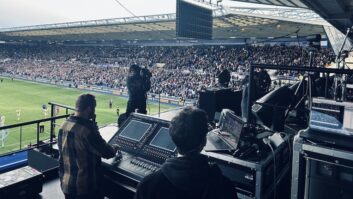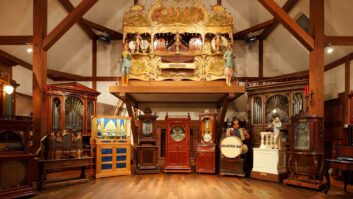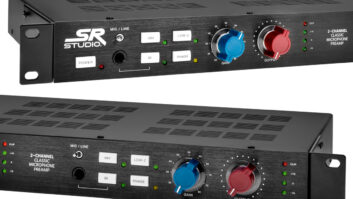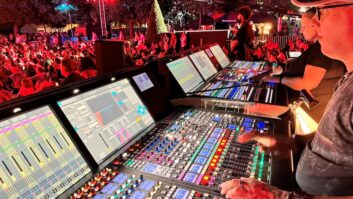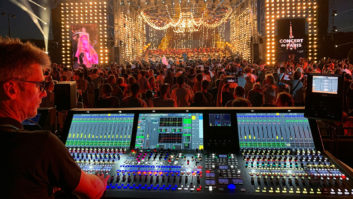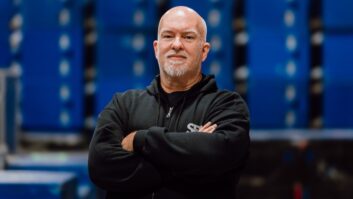DENMARK—It’s a common sight at festivals to see cell phones waving in the air, whether people are leaving a distorted-beyondbelief recording on a friend’s answering machine or just replicating the lighter held aloft from years gone by. If the work of Danish professor Jakob Eg Larsen Ph.D. comes to fruition, fans might wind up using their phones to hear better, too.
Beta-testers try out a prototype system that would augment festival concert sound by broadcasting audio to special app-equipped smartphones.An associate professor at the Technical University of Denmark’s Dept. of Informatics and Mathematical Modeling, Cognitive Systems Section in Kongens Lyngby, Larsen and his team have been developing an experimental project to augment festival PA systems by using smartphones as wireless personal delay systems. The idea is based around a custom-written app and lowpower FM broadcasting.

Larsen explained his current system prototype, offering, “In the current setup, [listeners] are wearing headphones. The music from the speakers at the stage is so loud that you need to wear some kind of headset or in-ear device to be able to hear the sound from both sources—the headset and stage speakers. When you do that, you will typically have a better experience of some frequencies, such as vocal and guitar, whereas the bass and drums and so on, you receive from the speakers at the stage and feel in your body.”
A split of the house mix is sent to an FM radio antenna, which broadcasts the show on a frequency picked up by smartphones that have built-in FM receivers. Of course, radio waves travel much faster than sound, so the phone app delays the signal, calculating the time difference by using the phone’s GPS to figure out the listener’s distance from the main PA. However, the GPS can’t pinpoint the listener’s exact location; it can only create a rough estimate, so the delayed audio has to be fine-tuned by the user for now. Determined to overcome the problem, Larsen and his research team are looking into using the phone’s microphone to capture audio that the app would then compare and use to synch the real-world and FM sources together.
The system’s first trial run was held last summer at Denmark’s Nibe Music Festival, where 19 random music fans were asked to try out the app on a Nokia N900 phone, which has a built-in FM receiver. While the experiment went well, it also underlined the fledgling system’s Achilles Heel: latency.
“The biggest delay in our current prototype is in the components in the mobile phone, where we need to introduce a delay to the FM playback in order to align the two signals,” said Larsen. “A delay of roughly 200 ms is introduced by the phone. This means that you cannot be closer than approximately 70 meters using the current prototype. We can bring down that delay in future implementations.” Larsen expects to reduce that distance to roughly 20 meters, and also notes that the system could be used as a way to provide additional audio information to the listener—think artistic uses like additional soundscapes at a Nine Inch Nails show or perhaps surround sound beats at a Jay-Z concert.
While Larsen and his team have been working on the cell phone PA supplement concept for roughly a year, the idea behind it took root over a decade ago in the form of a theater concert, “Stairways to Heaven,” created by technologist/event promoter Claus Vesterskov and his company CrossOver Global in 1999. Audience members were equipped with “3D sound headphones” and the resulting multimedia show was nominated for the Reumert—Danish theater’s equivalent of the Tony Awards.
Back in the 1990s, dedicated technology was necessary for the concept, but Vesterskov never gave up on finding a way to make it more mainstream, and he decided to revisit the idea last year. “It started at a matchmaking event in February 2010, hosted by the Danish Sound Technology Network,” said Larsen. “Claus Vesterskov pitched the idea to an expert panel of representatives from the Danish sound technology sector. A team was put together to develop the idea, and an innovation project with the Technical University of Denmark, financed by the Danish Sound Technology Network, was initiated.”
Now, with the Nibe festival test-run under their belts, Larsen and the team are moving ahead, exploring how best to turn the prototype into a viable product. Does that mean dropping FM and moving to streamed audio over a WiFi or 3G network? Larsen doesn’t say, but for now, he allows, “The current implementation has served as a proof-of-concept. We are working together towards practical development and deployment of the technology, and CrossOver Global is working on towards introducing a first version of the system.”
CrossOver Global
crossoverglobal.dk
Danish Sound Technology Network
soundtechnology.dk

